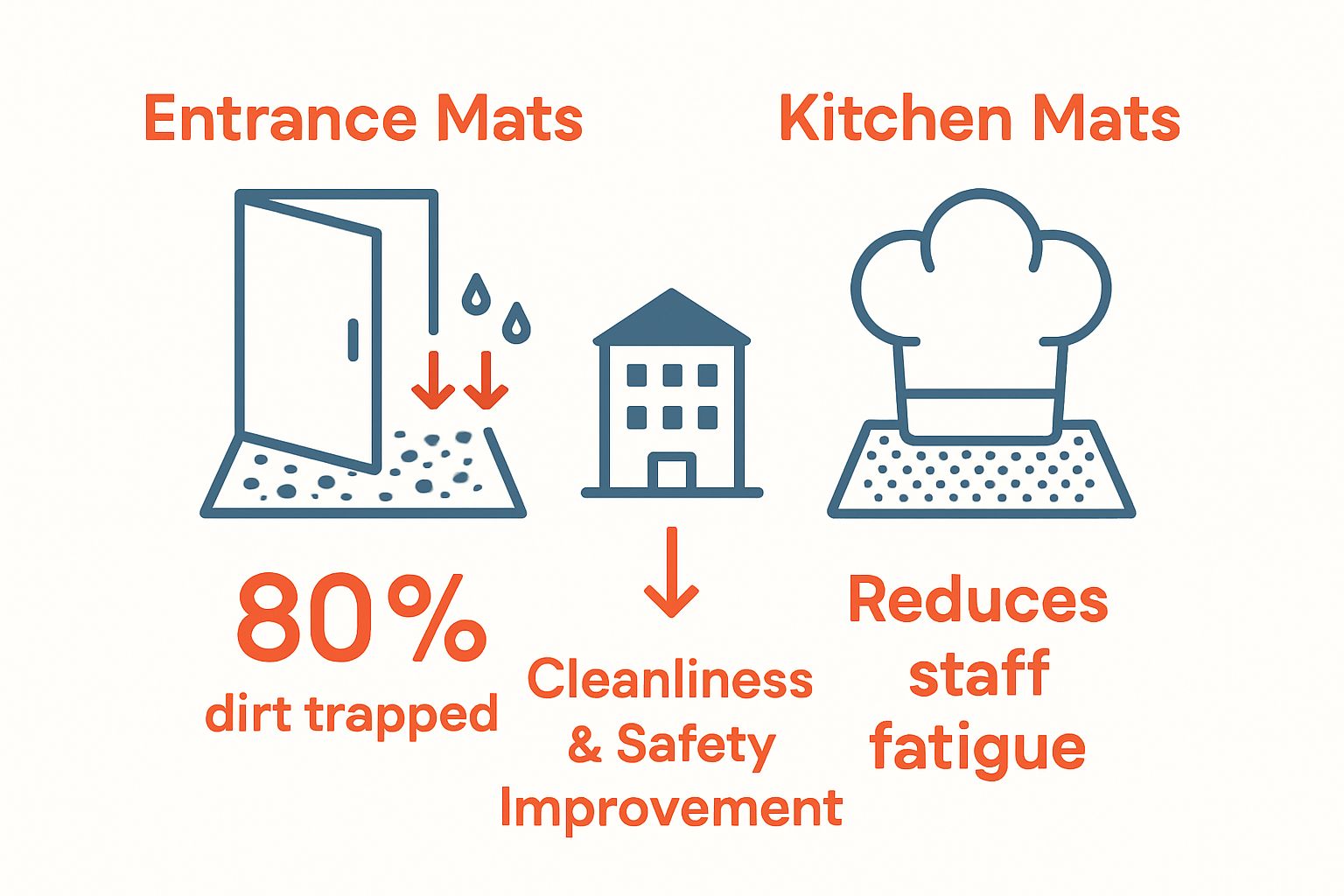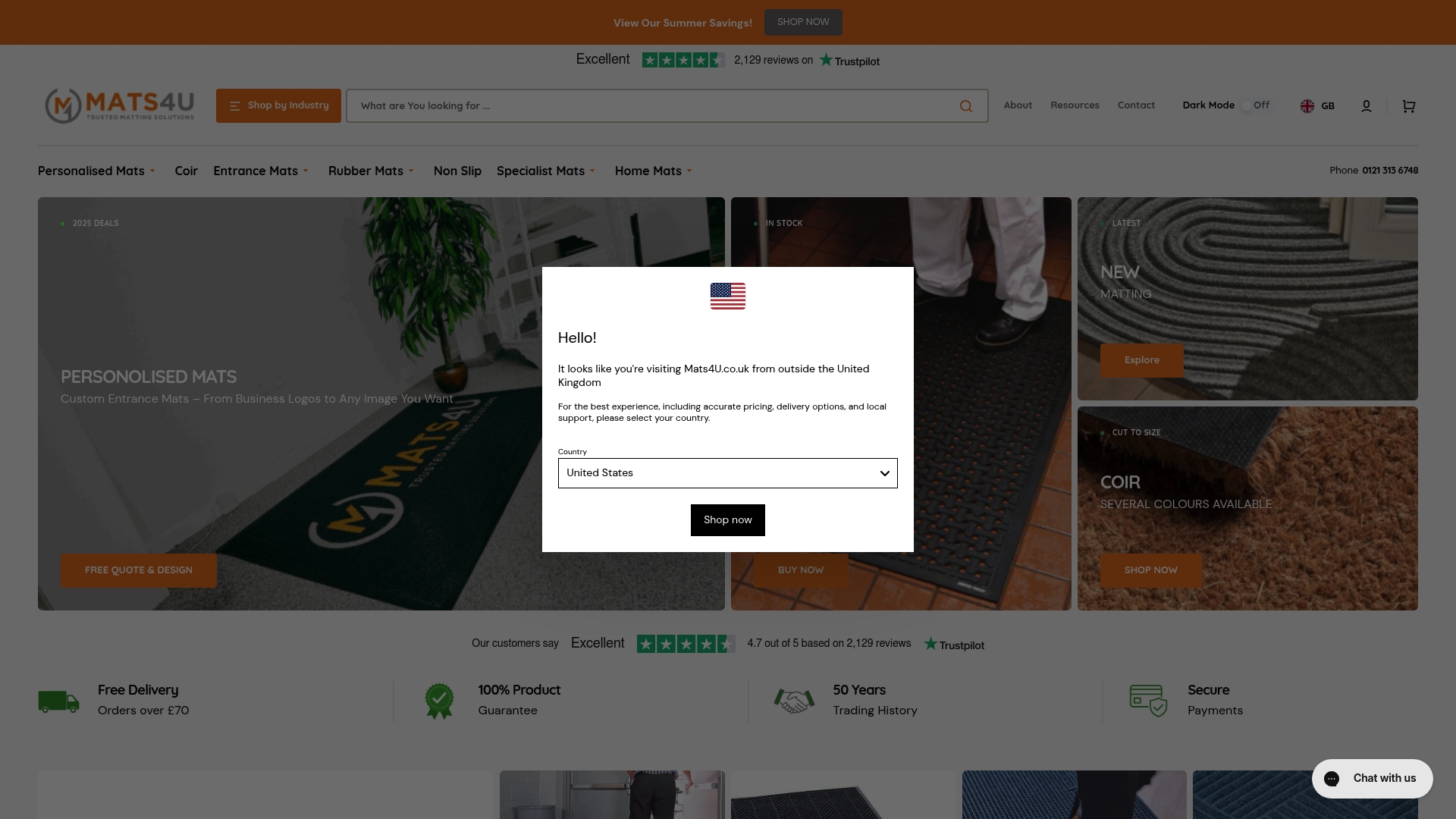Floor mats in hotels might look like simple strips of rubber or textile, but their job goes far beyond appearance. Hotels using professional-grade entrance mats can actually capture up to 80 percent of incoming dirt and moisture in just a few steps. Most people focus on the furniture, lighting, or overall design when talking about guest experience. Yet much of a hotel’s safety, cleanliness, and even brand image begins right at your feet.
Table of Contents
- What Are Floor Mats For Hotels?
- The Importance Of Floor Mats In The Hospitality Sector
- Types Of Floor Mats And Their Unique Benefits
- How Floor Mats Contribute To Safety And Cleanliness
- Selecting The Right Floor Mats For Your Hotel Needs
Quick Summary
| Takeaway | Explanation |
|---|---|
| Invest in high-quality mats | Quality mats reduce slip hazards and improve cleanliness in hotels. |
| Select mats based on zone use | Different areas need specific mats for optimal safety and functionality. |
| Prioritise branding in mat design | Customised mats enhance guests’ first impressions and service perception. |
| Use mats as safety and cleanliness tools | They trap dirt and moisture, reducing contamination and accidents. |
| Evaluate materials and performance | Choose materials that balance durability, appearance, and operational needs. |
What Are Floor Mats for Hotels?
Floor mats in hotels are specialised textile and rubber coverings strategically placed throughout hospitality spaces to enhance safety, cleanliness, and aesthetic appeal. These functional accessories serve multiple critical purposes beyond mere decoration, acting as the first line of defence against dirt, moisture, and potential slip hazards.
Functional Purpose of Hotel Floor Mats
In the hospitality industry, floor mats are not just simple floor coverings but sophisticated solutions designed to address specific environmental challenges. They perform several key functions that directly impact guest experience and operational efficiency. Learn more about commercial mat solutions can provide deeper insights into professional mat management.
Hotel floor mats typically serve three primary objectives:
- Safety Prevention: Reducing slip and fall incidents by providing textured, non-slip surfaces in high-traffic areas
- Dirt Containment: Capturing external debris, moisture, and contaminants before they enter interior spaces
- Brand Representation: Creating visual first impressions through customised designs and logos
Types of Floor Mats in Hospitality Environments
Hotels utilise diverse mat types tailored to specific zones and functional requirements. Entrance mats, often the most critical, are engineered to withstand high foot traffic while effectively trapping dirt and moisture. According to research on commercial flooring, professional-grade entrance mats can capture up to 80% of incoming dirt and moisture within the first few steps.
Other specialized mat categories include:
- Lobby and reception area mats with decorative designs
- Kitchen and back-of-house anti-fatigue mats
- Bathroom and wet area non-slip mats
- Branded welcome mats for distinctive guest experiences
By integrating strategically selected floor mats, hotels create safer, cleaner, and more visually appealing environments that contribute significantly to overall guest satisfaction and operational standards.
The following table provides a concise comparison of different types of hotel floor mats, outlining their typical locations, key features, and specific operational benefits.
| Mat Type | Typical Location | Key Features | Main Benefits |
|---|---|---|---|
| Entrance/Reception Mats | Main entrance, reception areas | High durability, moisture absorption | Trap dirt/moisture, prevent slips |
| Decorative Lobby Mats | Lobby, guest waiting areas | Custom designs, aesthetic appeal | Enhance visual impression |
| Kitchen/Anti-Fatigue Mats | Kitchens, back-of-house zones | Cushioning, anti-slip, durable | Reduce staff fatigue, increase safety |
| Wet Area Mats | Bathrooms, pools, spa areas | Non-slip, rapid drainage | Prevent slips, maintain hygiene |
| Branded Welcome Mats | Entrances, main walkways | Custom branding, durable construction | Promote brand image, greet guests |
| Back of House Mats | Staff corridors, service areas | Robust, easy to clean | Support staff movement, safety |
The Importance of Floor Mats in the Hospitality Sector
In the competitive hospitality landscape, floor mats transcend their basic functional role, emerging as strategic assets that significantly impact guest experience, operational efficiency, and brand perception. Hotels and hospitality establishments increasingly recognise these seemingly simple accessories as critical components of their overall service quality and safety infrastructure.
Economic and Safety Implications
The economic rationale for investing in high-quality floor mats is compelling. Learn about preventing entrance mat failures to understand the long-term benefits of strategic mat selection. According to research from the Health and Safety Executive, slip and fall accidents constitute a significant proportion of workplace injuries, with potential legal and financial repercussions for hospitality businesses.
Key economic considerations include:
- Reducing potential insurance claims and legal liabilities
- Minimising workplace accident rates
- Extending floor surface longevity
- Decreasing maintenance and cleaning expenditures
Brand Image and Guest Experience
Beyond safety, floor mats serve as subtle yet powerful branding tools. They represent the first tactile and visual interaction guests have with a hospitality space. Thoughtfully selected mats communicate attention to detail, cleanliness standards, and overall service quality.
Consider how different mat characteristics contribute to guest perceptions:
- Texture and Design: Communicating sophistication and professional standards
- Cleanliness: Demonstrating rigorous hygiene protocols
- Material Quality: Reflecting investment in guest comfort
Moreover, specialised mats in different zones create distinct impressions. Entrance mats make immediate statements about the establishment’s character, while lobby mats reinforce aesthetic and brand messaging. Kitchen and staff areas benefit from functional mats that support worker comfort and safety, indirectly enhancing service quality.
By strategically deploying floor mats, hospitality businesses transform these seemingly mundane accessories into sophisticated tools for safety management, brand communication, and operational excellence.
Types of Floor Mats and Their Unique Benefits
Hotels require a nuanced approach to floor matting, with different zones demanding specialised solutions that address specific environmental challenges and functional requirements. Understanding the unique characteristics of various mat types enables hospitality managers to create comprehensive floor protection strategies.
Entrance and Reception Floor Mats
Entrance mats represent the critical first line of defence against external contaminants and moisture. Explore our guide on outdoor mat solutions to understand their strategic importance. According to health and safety guidelines, these mats play a crucial role in preventing slip hazards and maintaining interior cleanliness.
Key characteristics of effective entrance mats include:
- High moisture absorption capabilities
- Robust construction for heavy foot traffic
- Quick-drying textile technologies
- Decorative designs that complement hotel aesthetics
Specialised Functional Mats
Beyond entrance zones, hotels utilise targeted mat solutions for specific operational requirements. These specialised mats address unique challenges in different environments, enhancing both safety and operational efficiency.
Mat categories tailored for specific hotel zones:

- Kitchen Mats: Anti-fatigue designs supporting staff comfort and reducing workplace strain
- Wet Area Mats: Enhanced grip surfaces for swimming pools, spa areas, and bathroom facilities
- Back of House Mats: Durable surfaces supporting continuous staff movement
- Branded Welcome Mats: Customised designs reinforcing hotel identity
Each mat type is engineered with precise material technologies to address specific environmental demands.
 Rubber compounds, textile weaves, and ergonomic designs transform these floor coverings from simple accessories into sophisticated operational tools that contribute directly to guest experience and staff productivity.
Rubber compounds, textile weaves, and ergonomic designs transform these floor coverings from simple accessories into sophisticated operational tools that contribute directly to guest experience and staff productivity.
How Floor Mats Contribute to Safety and Cleanliness
In the hospitality sector, floor mats serve as sophisticated protective mechanisms that simultaneously address safety concerns and maintain rigorous cleanliness standards. Their strategic deployment transforms them from simple floor coverings into critical infrastructure components that directly impact guest experience and operational efficiency.
Safety Risk Mitigation
Safety represents the primary function of professionally designed floor mats. Our comprehensive guide to commercial mat maintenance offers deeper insights into their protective capabilities. According to workplace safety research, strategic mat placement can significantly reduce slip and fall incidents by capturing moisture and providing textured surfaces.
Key safety features include:
- Textured surface designs preventing accidental slips
- Bevelled edges reducing tripping hazards
- High friction materials enhancing traction
- Shock absorption protecting joints during extended standing periods
Cleanliness and Contamination Control
Beyond safety, floor mats act as sophisticated filtration systems that prevent external contaminants from entering controlled environments. Advanced mat technologies trap dirt, moisture, and particulate matter, maintaining pristine interior spaces and reducing cleaning expenditures.
Cleanliness management strategies encompass:
- Dirt Trapping: Capturing up to 70% of external debris before entering interior spaces
- Moisture Absorption: Preventing water tracking across floor surfaces
- Allergen Containment: Reducing airborne particulate movement
- Cross Contamination Prevention: Creating barrier zones between different operational areas
By integrating intelligent floor mat solutions, hotels transform these seemingly simple accessories into sophisticated environmental management tools that protect both human safety and interior infrastructure.
Selecting the Right Floor Mats for Your Hotel Needs
Choosing appropriate floor mats involves a strategic approach that balances functional requirements, aesthetic considerations, and long-term performance. Hotel managers must navigate a complex landscape of material technologies, design specifications, and operational constraints to make informed matting decisions.
Critical Selection Criteria
Effective mat selection demands comprehensive evaluation of multiple factors. Explore essential tips for commercial matting to understand nuanced selection processes. According to workplace safety guidelines, proper mat selection must consider foot traffic volume, environmental conditions, and specific operational zones.
Key selection considerations include:
- Precise measurement of entrance and high traffic areas
- Assessment of moisture and contamination levels
- Understanding specific zone requirements
- Budgetary constraints and long term maintenance costs
Material and Performance Evaluation
Different mat materials offer unique performance characteristics tailored to specific hotel environments. Selecting appropriate materials requires understanding their inherent properties and potential limitations.
Mat material performance categories:
- Rubber Mats: Maximum durability for high traffic zones
- Textile Mats: Superior moisture absorption and aesthetic flexibility
- Synthetic Blends: Balanced performance across multiple operational requirements
- Specialised Composites: Enhanced technical capabilities for challenging environments
Successful mat selection transcends simple aesthetic choices, representing a sophisticated infrastructure decision that directly impacts guest experience, operational safety, and long term facility maintenance strategies.
This table summarises the key criteria and evaluation points for selecting hotel floor mats, assisting managers in making informed decisions based on functional needs and materials.
| Selection Criteria | Explanation |
|---|---|
| Area Measurement | Accurate measurement of entrances and high traffic zones |
| Foot Traffic Volume | Assessment of expected daily usage |
| Environmental Conditions | Consideration of moisture, dirt, and contamination exposure |
| Zone Requirements | Identifying specific needs per operational zone |
| Material Characteristics | Evaluation of durability, moisture absorption, traction |
| Budget & Maintenance | Cost analysis including installation and ongoing care |
Elevate Safety and First Impressions with Hotel Floor Mat Solutions
Are you finding it difficult to balance guest safety with a welcoming first impression? As discussed above, hotels often struggle with issues like slip hazards, dirt control, and maintaining a polished brand image. With strategic use of floor mats, you can address these pain points head-on by reducing the risk of accidents, keeping interiors pristine, and promoting your hotel’s unique style. Discover smart, made-to-measure solutions designed to tackle the everyday challenges of hospitality by exploring our specialist Hotel & Leisure Mats.

Do not let another guest see rainwater tracked through your lobby or risk a costly slip incident. Visit Mats4U now for expert advice and to browse our full range of customised matting. Ready to upgrade other specialised areas? Find solutions for staff changing rooms or pool zones at our Changing Room Mats collection. Act today and protect your guests, your staff, and your reputation with professional matting built for hotels.
Frequently Asked Questions
What are the primary functions of floor mats in hotels?
Floor mats in hotels serve three main purposes: enhancing safety by reducing slip and fall risks, containing dirt and moisture to maintain cleanliness, and representing the hotel brand through customised designs and logos.
How do entrance mats benefit hotel cleanliness and safety?
Entrance mats effectively trap dirt and moisture before it enters the hotel, capturing up to 80% of contaminants, which reduces slip hazards and the workload for cleaning staff, ensuring a cleaner and safer environment for guests.
What types of floor mats are used in different hotel areas?
Hotels utilise various types of mats, including entrance mats for high-traffic areas, decorative lobby mats for visual appeal, anti-fatigue kitchen mats for staff comfort, non-slip bathroom mats, and branded welcome mats that enhance guest experience.
What factors should be considered when selecting floor mats for a hotel?
Key factors include assessing foot traffic volume, environmental conditions, the specific functional requirements of different zones, precise measurements of areas, and evaluating material performance characteristics to ensure long-term durability and cleanliness.









